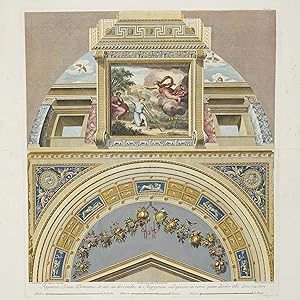raphael sanzio durbino (21 résultats)
Type d'article
- Tous les types d'articles
- Livres (4)
- Magazines & Périodiques
- Bandes dessinées
- Partitions de musique
- Art, Affiches et Gravures (17)
- Photographies
- Cartes
-
Manuscrits &
Papiers anciens
Etat
- Tous
- Neuf
- Ancien ou d'occasion
Reliure
- Toutes
- Couverture rigide (1)
- Couverture souple
Particularités
- Edition originale
- Signé
- Jaquette
- Avec images (18)
- Sans impression à la demande
Pays
Evaluation du vendeur
-
PORTRAIT OF POPE JULIUS II, By Raphael Sanzio d'Urbino - an Original Antique Engraving
Date d'édition : 1832
Vendeur : K Books Ltd ABA ILAB, York, YORKS, Royaume-Uni
Livre
No Binding. Etat : Very Good. Urbino (illustrateur). An original antique print, engraved by R Page from the painting by Raphael Sanzio d'Urbino. Mounted (matted) and ready to frame . Very good condition .
-
Maddalena Doni" und "Angelo Doni". Gegenstücke. Hüftbilder nach halbrechts bzw. halblinks, sitzend vor einer Landschaft, unten Inschrift.
Vendeur : Franziska Bierl Antiquariat, Eurasburg, Allemagne
Art / Affiche / Gravure
2 Lithographien von F. Pierucci bzw. F. Pieraccini nach Raffael bei L. Bardi, Firenze, 1829, je 26 x 18,5 cm. Thiem-Becker Bd. XXVI, S. 598; Nagler, Pieraccini 1 und Pierucci 1; Höper B 17 und B 18: "Angelo Doni heiratete 1503 die 1489 geborene Maddalena Strozzi und ließ das Bildnis seiner Frau sowie sein eigenes von Raffael anfertigen". - Minimal fleckig. Breitrandig.
-
PSYCHES ET AMORIS NUPTIAE AC FABULA A RAPHAELE SANCTIO URBINATE ROMAE IN FARNESIANIS HORTIS TRANSTYBERIM AD VETERUM AEMULATIONEM AC LAUDEM COLORUM LUMINIBUS EXPRESSA A. DORIGNY. DELINEATA ET INCISA, ET A IOANNE PETRO BELLORIO NOTIS ILLUSTRATA.
Edité par Rome: Typis ac sumptibus Dominici de Rubeis Io. Iacobi filii ac heredis, 1693., 1693
Vendeur : Charles Russell, ABA, ILAB, est 1978, Cirencester, Royaume-Uni
Livre
Large folio 25 x 15 inches from the margins. No binding- loose. Title and 10 PLATES by Dorigny, numbered 1 to 11. Margins of the title frayed, plates trimmed very near to the image - some spotting, plate 4 with a small old damp stain (washable), old central fold where originally bound. It can come with an additional plate 12 of the ceiling fresco in the adjoining Sala di Galatea- not here present. A valuable and very beautiful engraved record of Raphael's Cupid and Psyche frescoes, which he completed between 1516 and 1518 in the Loggia of Psyche of Agostino Chigi's Villa Farnesina in Rome. Sold as a collection of engravings. Bibliography- Berlin Katalog 4066.
-
[Angels appear to Abraham] Apparuerunt ei tres viri, et cucurrit Abraham de ostio Tabernaculi sui, et adoravit in Terram
Edité par Rome, 1774
Vendeur : Donald A. Heald Rare Books (ABAA), New York, NY, Etats-Unis
Art / Affiche / Gravure
Copper engraving by Ottaviani after drawings by Savorelli and Camporesi, printed in light brown coloured ink with contemporary hand-colouring. Neat marginal restoration. A stunning plate from "Logge di Rafaele nel Vaticano": with contemporary colouring of the highest quality from the golden age of the hand-coloured print. The scene in the main panel shows the three angels that appeared to Abraham and told him that he and his wife Sarah will have a son. A very fine image from the second part of a work titled "Loggie di Rafaele nel Vaticano" depicting the decorative work executed by Raphael and his assistants between 1518-1519 in the Vatican. They were drawn by Gaetano Savorelli, a Roman painter and draughtsman best known for his Raphael drawings, and Pietro Camporesi, a Roman architect, who worked for Pope Clemens XIII and Pius VI on rooms for the Vatican Museum. The first to illustrate the famous frescoes, these beautiful plates were probably planned as early as 1760, but were not executed until 1772 to 1776. The plate is remarkable not only as the first important visual record of Raphael's work, but also for the quality of the hand-colouring - the work on this image is, in our opinion, some of the greatest to be produced in Europe during the whole of the eighteenth century: the golden age of the hand-coloured print. They were remarkable not just for their size and magnificent colouring, but also because of the influence they had on contemporary taste. The decision was made to "borrow" elements from Raphael's Vatican tapestries and insert them where the original frescoes were in too poor a state to be legible. The finished plates therefore represented an amalgam of design elements presented with a crisp freshness of colour that held enormous appeal and did much to stimulate the taste for the "grotesque" in the Neo-classical period. A year after the death of his principal patron Julius II, Raphael succeeded Donato Bramante in 1514 as the official Vatican architect. Having previously adorned the "Stanze" or chambers of Julius on the second floor of the papal apartments in the Vatican palace, he was commissioned by Leo X in 1517 to decorate the adjacent Logge. He designed an elaborate cycle of ornamental frescoes for the room's ceiling vaults, doors and auxiliary pillars, which were executed by his assistants Giulio Romano and Giovanni da Udine. Twelve of the quadrilateral ceiling vaults were adorned with murals of familiar Old Testament scenes and one with a scene from the New Testament, while the more decorative frescoes painted on the pilasters by Udine were covered with imaginative compositions of 'grotesque' motifs like foliage, fruit, and chimerical beasts. Cf. Brunet IV, 1110 & 1111; cf. Berlin Katalog 4068 & 4066; "Raphael Invenit: Stampe da Rafaello" (1985) Ottaviano 22; cf. "Raphael: Reproduktions-graphik aus vier Jahrhunderten" (Coburg 1984) 104 & no. 245.
-
[King David in Triumph] Subacta Syria, tulit David arma aurea, et detula ea in Jerusalem
Edité par Rome, 1774
Vendeur : Donald A. Heald Rare Books (ABAA), New York, NY, Etats-Unis
Art / Affiche / Gravure
Copper engraving, on two joined sheets, by Ottaviani after drawings by Savorelli and Camporesi, printed in light brown coloured ink with contemporary hand-colouring. Neat marginal restoration. A stunning plate from "Logge di Rafaele nel Vaticano": with contemporary colouring of the highest quality from the golden age of the hand-coloured print. The main panel shows King David, having subdued Syria, returning to Jersusalem with armour made of gold. A very fine image from the second part of a work titled "Loggie di Rafaele nel Vaticano" depicting the decorative work executed by Raphael and his assistants between 1518-1519 in the Vatican. They were drawn by Gaetano Savorelli, a Roman painter and draughtsman best known for his Raphael drawings, and Pietro Camporesi, a Roman architect, who worked for Pope Clemens XIII and Pius VI on rooms for the Vatican Museum. The first to illustrate the famous frescoes, these beautiful plates were probably planned as early as 1760, but were not executed until 1772 to 1776. The plate is remarkable not only as the first important visual record of Raphael's work, but also for the quality of the hand-colouring - the work on this image is, in our opinion, some of the greatest to be produced in Europe during the whole of the eighteenth century: the golden age of the hand-coloured print. They were remarkable not just for their size and magnificent colouring, but also because of the influence they had on contemporary taste. The decision was made to "borrow" elements from Raphael's Vatican tapestries and insert them where the original frescoes were in too poor a state to be legible. The finished plates therefore represented an amalgam of design elements presented with a crisp freshness of colour that held enormous appeal and did much to stimulate the taste for the "grotesque" in the Neo-classical period. A year after the death of his principal patron Julius II, Raphael succeeded Donato Bramante in 1514 as the official Vatican architect. Having previously adorned the "Stanze" or chambers of Julius on the second floor of the papal apartments in the Vatican palace, he was commissioned by Leo X in 1517 to decorate the adjacent Logge. He designed an elaborate cycle of ornamental frescoes for the room's ceiling vaults, doors and auxiliary pillars, which were executed by his assistants Giulio Romano and Giovanni da Udine. Twelve of the quadrilateral ceiling vaults were adorned with murals of familiar Old Testament scenes and one with a scene from the New Testament, while the more decorative frescoes painted on the pilasters by Udine were covered with imaginative compositions of 'grotesque' motifs like foliage, fruit, and chimerical beasts. Cf. Brunet IV, 1110 & 1111; cf. Berlin Katalog 4068 & 4066; "Raphael Invenit: Stampe da Rafaello" (1985) Ottaviano 22; cf. "Raphael: Reproduktions-graphik aus vier Jahrhunderten" (Coburg 1984) 104 & no. 245.
-
[Jacob's Ladder] Vidit Jacob in somnis scalam stantem super terram, et cacumen illius tangens Coelum: Angelos ascendentes et descendentes: et Dnum innixum scalæ
Edité par Rome, 1770
Vendeur : Donald A. Heald Rare Books (ABAA), New York, NY, Etats-Unis
Art / Affiche / Gravure
Copper engraving, on two joined sheets, by Ottaviani after drawings by Savorelli and Camporesi, printed in light brown coloured ink with contemporary hand-colouring. Neat marginal restoration. A stunning plate from "Logge di Rafaele nel Vaticano": with contemporary colouring of the highest quality from the golden age of the hand-coloured print. The main panel shows Jacob at Luza having a vision of the angels ascending and descending by a ladder which reached from earth to heaven. A very fine image from the second part of a work titled "Loggie di Rafaele nel Vaticano" depicting the decorative work executed by Raphael and his assistants between 1518-1519 in the Vatican. They were drawn by Gaetano Savorelli, a Roman painter and draughtsman best known for his Raphael drawings, and Pietro Camporesi, a Roman architect, who worked for Pope Clemens XIII and Pius VI on rooms for the Vatican Museum. The first to illustrate the famous frescoes, these beautiful plates were probably planned as early as 1760, but were not executed until 1772 to 1776. The plate is remarkable not only as the first important visual record of Raphael's work, but also for the quality of the hand-colouring - the work on this image is, in our opinion, some of the greatest to be produced in Europe during the whole of the eighteenth century: the golden age of the hand-coloured print. They were remarkable not just for their size and magnificent colouring, but also because of the influence they had on contemporary taste. The decision was made to "borrow" elements from Raphael's Vatican tapestries and insert them where the original frescoes were in too poor a state to be legible. The finished plates therefore represented an amalgam of design elements presented with a crisp freshness of colour that held enormous appeal and did much to stimulate the taste for the "grotesque" in the Neo-classical period. A year after the death of his principal patron Julius II, Raphael succeeded Donato Bramante in 1514 as the official Vatican architect. Having previously adorned the "Stanze" or chambers of Julius on the second floor of the papal apartments in the Vatican palace, he was commissioned by Leo X in 1517 to decorate the adjacent Logge. He designed an elaborate cycle of ornamental frescoes for the room's ceiling vaults, doors and auxiliary pillars, which were executed by his assistants Giulio Romano and Giovanni da Udine. Twelve of the quadrilateral ceiling vaults were adorned with murals of familiar Old Testament scenes and one with a scene from the New Testament, while the more decorative frescoes painted on the pilasters by Udine were covered with imaginative compositions of 'grotesque' motifs like foliage, fruit, and chimerical beasts. Cf. Brunet IV, 1110 & 1111; cf. Berlin Katalog 4068 & 4066; "Raphael Invenit: Stampe da Rafaello" (1985) Ottaviano 22; cf. "Raphael: Reproduktions-graphik aus vier Jahrhunderten" (Coburg 1984) 104 & no. 245.
-
[Joseph and His Brothers] Vidi consurgere manipulum meum, et stare, vestrosq: manipulos adorare meum . Et vidi quasi solem, et lunam, et stallas undecim adorare me
Edité par Rome, 1774
Vendeur : Donald A. Heald Rare Books (ABAA), New York, NY, Etats-Unis
Art / Affiche / Gravure
Copper engraving, on two joined sheets, by Ottaviani after drawings by Savorelli and Camporesi, printed in light brown coloured ink with contemporary hand-colouring. Neat marginal restoration. A stunning plate from "Logge di Rafaele nel Vaticano": with contemporary colouring of the highest quality from the golden age of the hand-coloured print. The main panel shows Joseph telling his brothers of his prophetic dreams "Hear my dream which I dreamed. I thought we were binding sheaves in the field: and my sheaf arose as it were, and stood, and your sheaves standing about bowed down before my sheaf . I saw in . [another] dream, as it were the sun, and the moon, and eleven stars worshipping me." A very fine image from the second part of a work titled "Loggie di Rafaele nel Vaticano" depicting the decorative work executed by Raphael and his assistants between 1518-1519 in the Vatican. They were drawn by Gaetano Savorelli, a Roman painter and draughtsman best known for his Raphael drawings, and Pietro Camporesi, a Roman architect, who worked for Pope Clemens XIII and Pius VI on rooms for the Vatican Museum. The first to illustrate the famous frescoes, these beautiful plates were probably planned as early as 1760, but were not executed until 1772 to 1776. The plate is remarkable not only as the first important visual record of Raphael's work, but also for the quality of the hand-colouring - the work on this image is, in our opinion, some of the greatest to be produced in Europe during the whole of the eighteenth century: the golden age of the hand-coloured print. They were remarkable not just for their size and magnificent colouring, but also because of the influence they had on contemporary taste. The decision was made to "borrow" elements from Raphael's Vatican tapestries and insert them where the original frescoes were in too poor a state to be legible. The finished plates therefore represented an amalgam of design elements presented with a crisp freshness of colour that held enormous appeal and did much to stimulate the taste for the "grotesque" in the Neo-classical period. A year after the death of his principal patron Julius II, Raphael succeeded Donato Bramante in 1514 as the official Vatican architect. Having previously adorned the "Stanze" or chambers of Julius on the second floor of the papal apartments in the Vatican palace, he was commissioned by Leo X in 1517 to decorate the adjacent Logge. He designed an elaborate cycle of ornamental frescoes for the room's ceiling vaults, doors and auxiliary pillars, which were executed by his assistants Giulio Romano and Giovanni da Udine. Twelve of the quadrilateral ceiling vaults were adorned with murals of familiar Old Testament scenes and one with a scene from the New Testament, while the more decorative frescoes painted on the pilasters by Udine were covered with imaginative compositions of 'grotesque' motifs like foliage, fruit, and chimerical beasts. Cf. Brunet IV, 1110 & 1111; cf. Berlin Katalog 4068 & 4066; "Raphael Invenit: Stampe da Rafaello" (1985) Ottaviano 22; cf. "Raphael: Reproduktions-graphik aus vier Jahrhunderten" (Coburg 1984) 104 & no. 245.
-
[Last Supper] Discumbentibus, et edentibus Discipulis, dixit Jesus unus ex Vobis me proditurus est
Edité par Rome, 1774
Vendeur : Donald A. Heald Rare Books (ABAA), New York, NY, Etats-Unis
Art / Affiche / Gravure
Copper engraving, on two joined sheets, by Ottaviani after drawings by Savorelli and Camporesi, printed in light brown coloured ink with contemporary hand-colouring. Neat marginal restoration. A stunning plate from "Logge di Rafaele nel Vaticano": with contemporary colouring of the highest quality from the golden age of the hand-coloured print. The main panel shows the moment during the Last Supper when Jesus announces that one of the twelve disciples will betray him. A very fine image from the second part of a work titled "Loggie di Rafaele nel Vaticano" depicting the decorative work executed by Raphael and his assistants between 1518-1519 in the Vatican. They were drawn by Gaetano Savorelli, a Roman painter and draughtsman best known for his Raphael drawings, and Pietro Camporesi, a Roman architect, who worked for Pope Clemens XIII and Pius VI on rooms for the Vatican Museum. The first to illustrate the famous frescoes, these beautiful plates were probably planned as early as 1760, but were not executed until 1772 to 1776. The plate is remarkable not only as the first important visual record of Raphael's work, but also for the quality of the hand-colouring - the work on this image is, in our opinion, some of the greatest to be produced in Europe during the whole of the eighteenth century: the golden age of the hand-coloured print. They were remarkable not just for their size and magnificent colouring, but also because of the influence they had on contemporary taste. The decision was made to "borrow" elements from Raphael's Vatican tapestries and insert them where the original frescoes were in too poor a state to be legible. The finished plates therefore represented an amalgam of design elements presented with a crisp freshness of colour that held enormous appeal and did much to stimulate the taste for the "grotesque" in the Neo-classical period. A year after the death of his principal patron Julius II, Raphael succeeded Donato Bramante in 1514 as the official Vatican architect. Having previously adorned the "Stanze" or chambers of Julius on the second floor of the papal apartments in the Vatican palace, he was commissioned by Leo X in 1517 to decorate the adjacent Logge. He designed an elaborate cycle of ornamental frescoes for the room's ceiling vaults, doors and auxiliary pillars, which were executed by his assistants Giulio Romano and Giovanni da Udine. Twelve of the quadrilateral ceiling vaults were adorned with murals of familiar Old Testament scenes and one with a scene from the New Testament, while the more decorative frescoes painted on the pilasters by Udine were covered with imaginative compositions of 'grotesque' motifs like foliage, fruit, and chimerical beasts. Cf. Brunet IV, 1110 & 1111; cf. Berlin Katalog 4068 & 4066; "Raphael Invenit: Stampe da Rafaello" (1985) Ottaviano 22; cf. "Raphael: Reproduktions-graphik aus vier Jahrhunderten" (Coburg 1984) 104 & no. 245.
-
[The Lord appears to Issac] Apparvit Isaac Dominus, et ait: ne descendas in Aegyptum, sed quiesce in terra, quam dixero tibi
Edité par Rome, 1774
Vendeur : Donald A. Heald Rare Books (ABAA), New York, NY, Etats-Unis
Art / Affiche / Gravure
Copper engraving, on two joined sheets, by Ottaviani after drawings by Savorelli and Camporesi, printed in light brown coloured ink with contemporary hand-colouring. Neat marginal restoration. A stunning plate from "Logge di Rafaele nel Vaticano": with contemporary colouring of the highest quality from the golden age of the hand-coloured print. In the main panel the Lord appears to Isaac and tells him not to go down into Egypt but to stay in Gerara. A very fine image from the second part of a work titled "Loggie di Rafaele nel Vaticano" depicting the decorative work executed by Raphael and his assistants between 1518-1519 in the Vatican. They were drawn by Gaetano Savorelli, a Roman painter and draughtsman best known for his Raphael drawings, and Pietro Camporesi, a Roman architect, who worked for Pope Clemens XIII and Pius VI on rooms for the Vatican Museum. The first to illustrate the famous frescoes, these beautiful plates were probably planned as early as 1760, but were not executed until 1772 to 1776. The plate is remarkable not only as the first important visual record of Raphael's work, but also for the quality of the hand-colouring - the work on this image is, in our opinion, some of the greatest to be produced in Europe during the whole of the eighteenth century: the golden age of the hand-coloured print. They were remarkable not just for their size and magnificent colouring, but also because of the influence they had on contemporary taste. The decision was made to "borrow" elements from Raphael's Vatican tapestries and insert them where the original frescoes were in too poor a state to be legible. The finished plates therefore represented an amalgam of design elements presented with a crisp freshness of colour that held enormous appeal and did much to stimulate the taste for the "grotesque" in the Neo-classical period. A year after the death of his principal patron Julius II, Raphael succeeded Donato Bramante in 1514 as the official Vatican architect. Having previously adorned the "Stanze" or chambers of Julius on the second floor of the papal apartments in the Vatican palace, he was commissioned by Leo X in 1517 to decorate the adjacent Logge. He designed an elaborate cycle of ornamental frescoes for the room's ceiling vaults, doors and auxiliary pillars, which were executed by his assistants Giulio Romano and Giovanni da Udine. Twelve of the quadrilateral ceiling vaults were adorned with murals of familiar Old Testament scenes and one with a scene from the New Testament, while the more decorative frescoes painted on the pilasters by Udine were covered with imaginative compositions of 'grotesque' motifs like foliage, fruit, and chimerical beasts. Cf. Brunet IV, 1110 & 1111; cf. Berlin Katalog 4068 & 4066; "Raphael Invenit: Stampe da Rafaello" (1985) Ottaviano 22; cf. "Raphael: Reproduktions-graphik aus vier Jahrhunderten" (Coburg 1984) 104 & no. 245.
-
Decorative pilaster with fruit, flowers, and tendrils
Edité par Rome, 1772
Vendeur : Donald A. Heald Rare Books (ABAA), New York, NY, Etats-Unis
Art / Affiche / Gravure
Copper engraving by Ottaviani after drawings by Savorelli and Camporesi, printed in light brown coloured ink with contemporary hand-colouring. Good condition. Trimmed to just within plate mark along lower margin, expert repairs to left margin, not affecting image area. A highly decorative print from the famous "Loggie di Rafaele nel Vaticano" series, with contemporary colouring of the highest quality from the golden age of the hand-coloured print. A very fine image from the first part of a work titled "Loggie di Rafaele nel Vaticano" depicting the decorative work executed by Raphael and his assistants between 1518-1519 in the Vatican. This remarkable print, one of the first to be published of the decoration of the Logge on the main storey of the Vatican apartments, was probably planned as early as 1760, but was not executed until between 1772 and 1776. The project as a whole was carried out by the painter Gaetano Savorelli, the draughtsman Ludovico Teseo, the architect Pietro Camporesi, and the engravers Giovanni Ottaviani and Giovanni Volpato. The plate is remarkable not only as the first important visual record of Raphael's work, but also for the quality of the hand-colouring - the work on this image is, in our opinion, some of the greatest to be produced in Europe during the whole of the eighteenth century: the golden age of the hand-coloured print. The whole series was of importance not just for the size and magnificent colouring of the prints, but also because of the influence they had on contemporary taste. The decision was made to "borrow" elements from Raphael's Vatican tapestries and insert them where the original frescoes were in too poor a state to be legible. The finished plates therefore represented an amalgam of design elements presented with a crisp freshness of colour that held enormous appeal and stimulated the taste for the "grotesque" in the neo-classical period. Cf. Brunet IV, 1110; cf. Berlin Katalog 4068; cf. Lambert Pattern and Design (V. & A.: 1983), p. 26; "Raphael Invenit: Stampe da Rafaello" (1985) Ottaviano 4; Raphael: Reproduktions-graphik aus vier Jahrhunderten (Coburg: 1984), p. 104.
-
Decorative pilaster with fruit, flowers, and tendrils
Edité par Rome, 1772
Vendeur : Donald A. Heald Rare Books (ABAA), New York, NY, Etats-Unis
Art / Affiche / Gravure
Copper engraving by Ottaviani after drawings by Savorelli and Camporesi, printed in light brown coloured ink with contemporary hand-colouring. Good condition. Trimmed to just within plate mark along lower margin, expert repair to upper left corner just affecting image area, small repairs to right blank margin. A highly decorative print from the famous "Loggie di Rafaele nel Vaticano" series, with contemporary colouring of the highest quality from the golden age of the hand-coloured print. A very fine image from the first part of a work titled "Loggie di Rafaele nel Vaticano" depicting the decorative work executed by Raphael and his assistants between 1518-1519 in the Vatican. This remarkable print, one of the first to be published of the decoration of the Logge on the main storey of the Vatican apartments, was probably planned as early as 1760, but was not executed until between 1772 and 1776. The project as a whole was carried out by the painter Gaetano Savorelli, the draughtsman Ludovico Teseo, the architect Pietro Camporesi, and the engravers Giovanni Ottaviani and Giovanni Volpato. The plate is remarkable not only as the first important visual record of Raphael's work, but also for the quality of the hand-colouring - the work on this image is, in our opinion, some of the greatest to be produced in Europe during the whole of the eighteenth century: the golden age of the hand-coloured print. The whole series was of importance not just for the size and magnificent colouring of the prints, but also because of the influence they had on contemporary taste. The decision was made to "borrow" elements from Raphael's Vatican tapestries and insert them where the original frescoes were in too poor a state to be legible. The finished plates therefore represented an amalgam of design elements presented with a crisp freshness of colour that held enormous appeal and stimulated the taste for the "grotesque" in the neo-classical period. Cf. Brunet IV, 1110; cf. Berlin Katalog 4068; cf. Lambert Pattern and Design (V. & A.: 1983), p. 26; "Raphael Invenit: Stampe da Rafaello" (1985) Ottaviano 5; Raphael: Reproduktions-graphik aus vier Jahrhunderten (Coburg: 1984), p. 104.
-
[Eve Conceived Cain and his brother Abel] Concepit Heva, et peperit Cain Frantremque ejus Abel
Edité par Rome, 1774
Vendeur : Donald A. Heald Rare Books (ABAA), New York, NY, Etats-Unis
Art / Affiche / Gravure
Copper engraving by Ottaviani after drawings by Savorelli and Camporesi, printed in light brown coloured ink with contemporary hand-colouring. Good condition. Shaved within plate mark, expert neat repairs to left margin, one just affecting the image area. A stunning plate from "Logge di Rafaele nel Vaticano": with contemporary colouring of the highest quality from the golden age of the hand-coloured print. A very fine image from the second part of a work titled "Loggie di Rafaele nel Vaticano" depicting the decorative work executed by Raphael and his assistants between 1518-1519 in the Vatican. They were drawn by Gaetano Savorelli, a Roman painter and draughtsman best known for his Raphael drawings, and Pietro Camporesi, a Roman architect, who worked for Pope Clemens XIII and Pius VI on rooms for the Vatican Museum. The first to illustrate the famous frescoes, these beautiful plates were probably planned as early as 1760, but were not executed until 1772 to 1776. The plate is remarkable not only as the first important visual record of Raphael's work, but also for the quality of the hand-colouring - the work on this image is, in our opinion, some of the greatest to be produced in Europe during the whole of the eighteenth century: the golden age of the hand-coloured print. They were remarkable not just for their size and magnificent colouring, but also because of the influence they had on contemporary taste. The decision was made to "borrow" elements from Raphael's Vatican tapestries and insert them where the original frescoes were in too poor a state to be legible. The finished plates therefore represented an amalgam of design elements presented with a crisp freshness of colour that held enormous appeal and did much to stimulate the taste for the "grotesque" in the Neo-classical period. A year after the death of his principal patron Julius II, Raphael succeeded Donato Bramante in 1514 as the official Vatican architect. Having previously adorned the "Stanze" or chambers of Julius on the second floor of the papal apartments in the Vatican palace, he was commissioned by Leo X in 1517 to decorate the adjacent Logge. He designed an elaborate cycle of ornamental frescoes for the room's ceiling vaults, doors and auxiliary pillars, which were executed by his assistants Giulio Romano and Giovanni da Udine. Twelve of the quadrilateral ceiling vaults were adorned with murals of familiar Old Testament scenes and one with a scene from the New Testament, while the more decorative frescoes painted on the pilasters by Udine were covered with imaginative compositions of 'grotesque' motifs like foliage, fruit, and chimerical beasts. The biblical scene depicted shows the infant brothers Cain and Abel vying for their mother's attention. Adam is sowing nearby. Cf. Brunet IV, 1110 & 1111; cf. Berlin Katalog. 4068 & 4066; "Raphael Invenit: Stampe da Rafaello" (1985) Ottaviano 22; cf. "Raphael: Reproduktions-graphik aus vier Jahrhunderten" (Coburg 1984) 104 & no. 245.
-
Decorative pilaster with fruit, flowers, and tendrils
Edité par Rome, 1772
Vendeur : Donald A. Heald Rare Books (ABAA), New York, NY, Etats-Unis
Art / Affiche / Gravure
Copper engraving by Ottaviani after drawings by Ludovico Teseo, printed in black with stunning later professional hand-colouring. Very good condition. A highly decorative print from the famous "Loggie di Rafaele nel Vaticano" series, with later professional hand-colouring. A very fine image from the first part of a work titled "Loggie di Rafaele nel Vaticano" depicting the decorative work and executed by Raphael and his assistants between 1518-1519 in the Vatican. This remarkable print, one of the first to be published of the decoration of the Logge on the main storey of the Vatican apartments, was probably planned as early as 1760, but was not executed until between 1772 and 1776. The project as a whole was carried out by the painter Gaetano Savorelli, the draughtsman Ludovico Teseo, the architect Pietro Camporesi, and the engravers Giovanni Ottaviani and Giovanni Volpato. The whole series was remarkable not just for the size and magnificent colouring of the prints, but also because of the influence they had on contemporary taste. The decision was made to "borrow" elements from Raphael's Vatican tapestries and insert them where the original frescoes were in too poor a state to be legible. The finished plates therefore represented an amalgam of design elements presented with a crisp freshness of colour that held enormous appeal and stimulated the taste for the "grotesque" in the neo-classical period. Cf. Brunet IV, 1110; cf. Berlin Katalog 4068; cf. Lambert Pattern and Design (V. & A.: 1983), p. 26; "Raphael Invenit: Stampe da Rafaello" (1985) Ottaviano 2; Raphael: Reproduktions-graphik aus vier Jahrhunderten (Coburg: 1984), p. 104.
-
Doorway to Vatican Loggia
Edité par Rome, 1772
Vendeur : Donald A. Heald Rare Books (ABAA), New York, NY, Etats-Unis
Art / Affiche / Gravure
Copper engraving by Ottaviani after drawings by Savorelli and Camporesi, printed in light brown coloured ink with contemporary hand-colouring. Good condition. Three repaired tears to the left blank margin. Sight size: 31 1/8 x 18 1/4 inches. A highly decorative print from the famous "Loggie di Rafaele nel Vaticano" series, with contemporary colouring of the highest quality from the golden age of the hand-coloured print. A very fine image from the first part of a work titled "Loggie di Rafaele nel Vaticano" depicting the decorative work executed by Raphael and his assistants between 1518-1519 in the Vatican. This remarkable print, one of the first to be published of the decoration of the Logge on the main storey of the Vatican apartments, was probably planned as early as 1760, but was not executed until between 1772 and 1776. The project as a whole was carried out by the painter Gaetano Savorelli, the draughtsman Ludovico Teseo, the architect Pietro Camporesi, and the engravers Giovanni Ottaviani and Giovanni Volpato. The plate is remarkable not only as the first important visual record of Raphael's work, but also for the quality of the hand-colouring - the work on this image is, in our opinion, some of the greatest to be produced in Europe during the whole of the eighteenth century: the golden age of the hand-coloured print. The whole series was of importance not just for the size and magnificent colouring of the prints, but also because of the influence they had on contemporary taste. The decision was made to "borrow" elements from Raphael's Vatican tapestries and insert them where the original frescoes were in too poor a state to be legible. The finished plates therefore represented an amalgam of design elements presented with a crisp freshness of colour that held enormous appeal and stimulated the taste for the "grotesque" in the neo-classical period. Cf. Brunet IV, 1110; cf. Berlin Katalog 4068; cf. Lambert Pattern and Design (V. & A.: 1983), p. 26; "Raphael Invenit: Stampe da Rafaello" (1985) Ottaviano 17; Raphael: Reproduktions-graphik aus vier Jahrhunderten (Coburg: 1984), p. 104.
-
Decorative pilaster with fruit, flowers, and tendrils
Edité par Rome, 1772
Vendeur : Donald A. Heald Rare Books (ABAA), New York, NY, Etats-Unis
Art / Affiche / Gravure
Copper engraving by Ottaviani after drawings by Savorelli and Camporesi, printed in light brown coloured ink with contemporary hand-colouring. Trimmed to platemark left margin. Good condition. A highly decorative print from the famous "Loggie di Rafaele nel Vaticano" series, with contemporary colouring of the highest quality from the golden age of the hand-coloured print. A very fine image from the first part of a work titled "Loggie di Rafaele nel Vaticano" depicting the decorative work executed by Raphael and his assistants between 1518-1519 in the Vatican. This remarkable print, one of the first to be published of the decoration of the Logge on the main storey of the Vatican apartments, was probably planned as early as 1760, but was not executed until between 1772 and 1776. The project as a whole was carried out by the painter Gaetano Savorelli, the draughtsman Ludovico Teseo, the architect Pietro Camporesi, and the engravers Giovanni Ottaviani and Giovanni Volpato. The plate is remarkable not only as the first important visual record of Raphael's work, but also for the quality of the hand-colouring - the work on this image is, in our opinion, some of the greatest to be produced in Europe during the whole of the eighteenth century: the golden age of the hand-coloured print. The whole series was of importance not just for the size and magnificent colouring of the prints, but also because of the influence they had on contemporary taste. The decision was made to "borrow" elements from Raphael's Vatican tapestries and insert them where the original frescoes were in too poor a state to be legible. The finished plates therefore represented an amalgam of design elements presented with a crisp freshness of colour that held enormous appeal and stimulated the taste for the "grotesque" in the neo-classical period. Cf. Brunet IV, 1110; cf. Berlin Katalog 4068; cf. Lambert Pattern and Design (V. & A.: 1983), p. 26; "Raphael Invenit: Stampe da Rafaello" (1985) Ottaviano 11; Raphael: Reproduktions-graphik aus vier Jahrhunderten (Coburg: 1984), p. 104.
-
Decorative pilaster with fruit, flowers, and tendrils
Edité par Rome, 1772
Vendeur : Donald A. Heald Rare Books (ABAA), New York, NY, Etats-Unis
Art / Affiche / Gravure
Copper engraving by Ottaviani after drawings by Savorelli and Camporesi, printed in light brown coloured ink with contemporary hand-colouring. Good condition. Sight size: 43 x 17 inches. A highly decorative print from the famous "Loggie di Rafaele nel Vaticano" series, with contemporary colouring of the highest quality from the golden age of the hand-coloured print. A very fine image from the first part of a work titled "Loggie di Rafaele nel Vaticano" depicting the decorative work executed by Raphael and his assistants between 1518-1519 in the Vatican. This remarkable print, one of the first to be published of the decoration of the Logge on the main storey of the Vatican apartments, was probably planned as early as 1760, but was not executed until between 1772 and 1776. The project as a whole was carried out by the painter Gaetano Savorelli, the draughtsman Ludovico Teseo, the architect Pietro Camporesi, and the engravers Giovanni Ottaviani and Giovanni Volpato. The plate is remarkable not only as the first important visual record of Raphael's work, but also for the quality of the hand-colouring - the work on this image is, in our opinion, some of the greatest to be produced in Europe during the whole of the eighteenth century: the golden age of the hand-coloured print. The whole series was of importance not just for the size and magnificent colouring of the prints, but also because of the influence they had on contemporary taste. The decision was made to "borrow" elements from Raphael's Vatican tapestries and insert them where the original frescoes were in too poor a state to be legible. The finished plates therefore represented an amalgam of design elements presented with a crisp freshness of colour that held enormous appeal and stimulated the taste for the "grotesque" in the neo-classical period. Cf. Brunet IV, 1110; cf. Berlin Katalog 4068; cf. Lambert Pattern and Design (V. & A.: 1983), p. 26; "Raphael Invenit: Stampe da Rafaello" (1985) Ottaviano 11; Raphael: Reproduktions-graphik aus vier Jahrhunderten (Coburg: 1984), p. 104.
-
Decorative pilaster with fruit, flowers, and tendrils
Edité par Rome, 1772
Vendeur : Donald A. Heald Rare Books (ABAA), New York, NY, Etats-Unis
Art / Affiche / Gravure
Copper engraving by Ottaviani after drawings by Savorelli and Camporesi, printed in light brown coloured ink with contemporary hand-colouring. Good condition. Sight size: 43 x 17 1/4 inches. A highly decorative print from the famous "Loggie di Rafaele nel Vaticano" series, with contemporary colouring of the highest quality from the golden age of the hand-coloured print. A very fine image from the first part of a work titled "Loggie di Rafaele nel Vaticano" depicting the decorative work executed by Raphael and his assistants between 1518-1519 in the Vatican. This remarkable print, one of the first to be published of the decoration of the Logge on the main storey of the Vatican apartments, was probably planned as early as 1760, but was not executed until between 1772 and 1776. The project as a whole was carried out by the painter Gaetano Savorelli, the draughtsman Ludovico Teseo, the architect Pietro Camporesi, and the engravers Giovanni Ottaviani and Giovanni Volpato. The plate is remarkable not only as the first important visual record of Raphael's work, but also for the quality of the hand-colouring - the work on this image is, in our opinion, some of the greatest to be produced in Europe during the whole of the eighteenth century: the golden age of the hand-coloured print. The whole series was of importance not just for the size and magnificent colouring of the prints, but also because of the influence they had on contemporary taste. The decision was made to "borrow" elements from Raphael's Vatican tapestries and insert them where the original frescoes were in too poor a state to be legible. The finished plates therefore represented an amalgam of design elements presented with a crisp freshness of colour that held enormous appeal and stimulated the taste for the "grotesque" in the neo-classical period. Cf. Brunet IV, 1110; cf. Berlin Katalog 4068; cf. Lambert Pattern and Design (V. & A.: 1983), p. 26; "Raphael Invenit: Stampe da Rafaello" (1985) Ottaviano 13;Raphael: Reproduktions-graphik aus vier Jahrhunderten (Coburg: 1984), p. 104.
-
Loggie di Rafaele nel Vaticano
Edité par Rome, 1777
Vendeur : Donald A. Heald Rare Books (ABAA), New York, NY, Etats-Unis
Art / Affiche / Gravure
Copper engraving by Volpato after a drawing by Camporesi, later professional hand-colouring. Good condition. Expert strengthening to verso of right outer blank margin, some old light creasing to 3 inches of the sheet. This beautiful perspective view of Raphael's Loggia, served as the frontispiece to the celebrated text, "Loggie di Rafaele nel Vaticano". This arresting print is a general perspective view of Raphael's design for the Loggia at the Vatican, with a large profile portrait of Raphael in a medallion over the entrance to the corridor. The plate served as the frontispiece to the first part of the "Logge di Rafaele nel Vaticano", which depicted the decorative work executed by Raphael and his assistants between 1518-1519 in the Vatican. This remarkable print, one of the first to be published of the decoration of the Logge on the main storey of the Vatican apartments, was probably planned as early as 1760, but was not executed until between 1772 and 1776. The project as a whole was carried out by the painter Gaetano Savorelli, the draughtsman Ludovico Teseo, the architect Pietro Camporesi, and the engravers Giovanni Ottaviani and Giovanni Volpato. The whole series was of importance not just for the size and magnificent colouring of the prints, but also because of the influence they had on contemporary taste. The decision was made to "borrow" elements from Raphael's Vatican tapestries and insert them where the original frescoes were in too poor a state to be legible. The finished plates therefore represented an amalgam of design elements presented with a crisp freshness of colour that held enormous appeal and stimulated the taste for the "grotesque" in the neo-classical period. Cf. Brunet IV, 1110; cf. Berlin Katalog 4068; Lambert Pattern and Design (V. & A.: 1983), p. 26; "Raphael Invenit: Stampe da Rafaello" (1985) Volpato 1; Raphael: Reproduktions-graphik aus vier Jahrhunderten (Coburg: 1984), p. 104; G. Marini (editor) Giovanni Volpato 1735-1803 (1988) no. 198.
-
Psyches et Amoris nuptiae ac fabula a Raphaele Sanctio Urbinate Romae in Farnesinianis hortis transtyberim ad veterum aemulationem ac laudem colorum luminibus expressa a Nicolavo Dorigny ad similitudinem delineata et incisa, et a Joanne Petro Bellorio notis illustrata. [The Story of the Wedding of Cupid and Psyche, Painted by Raphael Sanzio d'Urbino in the Farnesina, Rome?]
Edité par Rome: Dominico de Rossi, Jo. Jacobi (Jo. Jacobi de Rubeis), August 15, 1693
Vendeur : Wittenborn Art Books, San Francisco, CA, Etats-Unis
Art / Affiche / Gravure
Etat : Good. Oblong folio. 46.5 x 69 cm. (18.25 x 27.25 inches) page size. Suite of 12 engravings. Housed in a custom portfolio with painted boards, leather spine, large embossed leather label, leather ties and leather corners by the celebrated Russian-American binder Alexandr (Sasha) Mosalov. OCLC Number: 504754030Set of 12 engravings of Raphael's frescoes of scenes from the myth of Cupid (also known as Eros) and Psyche in the Villa Farnesina in Rome. Raphael's paintings illustrate part of the story The Metamorphoses of Lucius Apuleius (the only Latin novel to survive in its entirety). In this work, Venus, jealous of a beautiful mortal girl named Psyche, sends Cupid on an errand to punish the girl. Cupid instead falls in love with Psyche, and after a series of secrets, betrayals, and trials, the lovers are reunited, and Psyche is made immortal.The frescoes are painted on the vaults and ceiling above demilune reserves on the ground floor at the end of the entrance hall, now known as the Loggia of Psyche. Images of leafy garlands of fruit accentuate the arches of the vaults, also framing the classical images. The frescoes were commissioned by the Sienese banker Agostino Chigi, called ?magnifico? by his peers for his richly decorated villa and the elegant entertainments he hosted there. The paintings were recently restored and the Villa Farnesina is open to the public as a museum.Some foxing.
-
[Psyches et Amoris nuptiae fabula a Raphaele Sanctio Urbinate Romae in Farnesianis hortis Transtyberim ad veterum aemulationem ac laudem colorum luminibus expressa a. Dorigny. delineata et incisa, et a Ioanne Petro Belloriio notis illustrata]
Edité par Domenico de' Rossi, Rome, 1693
Vendeur : Donald A. Heald Rare Books (ABAA), New York, NY, Etats-Unis
Large folio. 10 hand-coloured engraved plates by Dorigny on laid paper (each 15 7/8 x 26 inches approximately), titles and imprints printed in gold, black ink-ruled borders, each plate cut to the edge of the image, mounted on large sheets of contemporary thick laid paper (each 29 3/8 x 40 3/8 inches approximately). Unbound A very fine suite of richly hand-coloured plates offering a stunning visual record of one of the best of the decorative interior schemes carried out by Raphael in Rome. This wonderful series records Raphael's 'Cupid and Psyche' series of frescoes, carried out by him between 1516 and 1518 in the Loggia of Psyche in the villa Farnesina in Rome. The series also comes with a title and an eleventh plate of the ceiling fresco in the adjoining Sala di Galatea, executed in 1512: neither the plate nor the title are present here. Originally published by the Rossis, the engravings are the work of Nicolas Dorigny (1658-1746) who lived and worked in Rome between about 1690 and 1719. The painter, classicist, and art historian Giovanni Pietro Bellori (1613-1696) provided the text at the foot of the plates (appropriate excerpts from Apuleuis's Golden Ass). "Raphael Invenit: Stampe da Rafaello" (1985) Dorigny 37-46; cf. Brunet IV, 1111; cf. Berlin Katalog 4066.
-
Etat : Très bon. Un titre-frontispice, un profil général dépliant (3 feuilles montées) de la galerie, 16 planches dépliantes à double page et numérotées A-B et I à XIV représentant 2 portes et 14 pilastres (partie I) - 13 planches dépliantes à double page représentant plafonds et voûtes (partie II) - 12 planches dépliantes à double page représentant des pilastres (partie III).Toutes ces planches sont gravées par Volpato d'après Raphael, et mises en couleurs.Chef-d'?uvre de l'art ornemental en Occident, la collection des Loges de Raphaël comprend l'étude architecturale de plafonds, voûtes, pilastres, colonnes et portes à la manière d'un décor de l'Antiquité romaine.Pour cela, Raphael s'inspire de sculptures, de marbres précieux, de pierres gravées, de la nature avec ses fleurs, ses animaux. de peinture, dont les «grotesques», ces peintures retrouvées sous terre, dans la la Domus Aurea de Néron. pour le côté décoratif, sans pour autant oublier le côté religieux puisque les voûtes sont décorées d'épisodes de l'Ancien et du Nouveau Testament.Dès leur achèvement en 1519, les Loges suscitèrent un enthousiasme unanime.En 1772, les excellents graveurs Giovanni Volpato (1733-1803) et Giovanni Ottaviani (1735-1808)reçurent du Pape Clément XIII, le privilège de graver les planches représentant la série de peintures des Loges de Raphael au Vatican. // ENGLISH // A title-frontispiece, a general folding profile (3 sheets mounted) of the gallery, 16 double-page folding plates numbered A-B and I to XIV representing 2 doors and 14 pilasters (part I) - 13 double-page folding plates representing ceilings and vaults (part II) - 12 double-page folding plates representing pilasters (part III)All these plates are engraved by Volpato after Raphael, and coloured.A masterpiece of Western ornamental art, Raphael's Loges collection includes an architectural study of ceilings, vaults, pilasters, columns and doors in the manner of Roman Antique decoration.For this, Raphael was inspired by sculptures, precious marbles, engraved stones, nature with its flowers and animals, and paintings, including the "grotesques", the paintings found underground in Nero's Domus Aurea, for the decorative aspect, without forgetting the religious aspect, since the vaults are decorated with episodes from the Old and New Testaments.From the moment of their completion in 1519, the Loges aroused unanimous enthusiasm.In 1772, the excellent engravers Giovanni Volpato (1733-1803) and Giovanni Ottaviani (1735-1808) received from Pope Clement XIII the privilege of engraving the plates representing the series of paintings of Raphael's Loges in the Vatican.



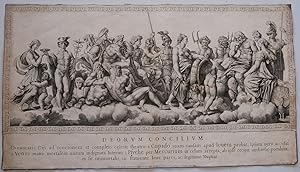
![Image du vendeur pour [Angels appear to Abraham] Apparuerunt ei tres viri, et cucurrit Abraham de ostio Tabernaculi sui, et adoravit in Terram mis en vente par Donald A. Heald Rare Books (ABAA)](https://pictures.abebooks.com/inventory/md/md1875946668.jpg)
![Image du vendeur pour [King David in Triumph] Subacta Syria, tulit David arma aurea, et detula ea in Jerusalem mis en vente par Donald A. Heald Rare Books (ABAA)](https://pictures.abebooks.com/inventory/md/md1875946670.jpg)
![Image du vendeur pour [Jacob's Ladder] Vidit Jacob in somnis scalam stantem super terram, et cacumen illius tangens Coelum: Angelos ascendentes et descendentes: et Dnum innixum scalæ mis en vente par Donald A. Heald Rare Books (ABAA)](https://pictures.abebooks.com/inventory/md/md1875946672.jpg)
![Image du vendeur pour [Joseph and His Brothers] Vidi consurgere manipulum meum, et stare, vestrosq: manipulos adorare meum . Et vidi quasi solem, et lunam, et stallas undecim adorare me mis en vente par Donald A. Heald Rare Books (ABAA)](https://pictures.abebooks.com/inventory/md/md1875946677.jpg)
![Image du vendeur pour [Last Supper] Discumbentibus, et edentibus Discipulis, dixit Jesus unus ex Vobis me proditurus est mis en vente par Donald A. Heald Rare Books (ABAA)](https://pictures.abebooks.com/inventory/md/md1875946680.jpg)
![Image du vendeur pour [The Lord appears to Issac] Apparvit Isaac Dominus, et ait: ne descendas in Aegyptum, sed quiesce in terra, quam dixero tibi mis en vente par Donald A. Heald Rare Books (ABAA)](https://pictures.abebooks.com/inventory/md/md1963905145.jpg)
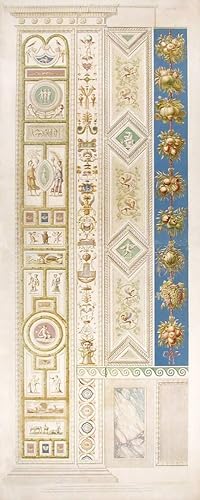
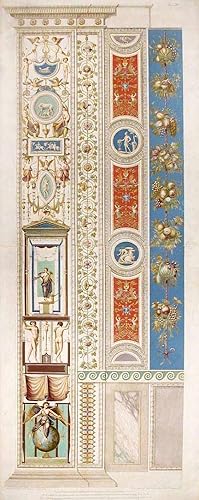
![Image du vendeur pour [Eve Conceived Cain and his brother Abel] Concepit Heva, et peperit Cain Frantremque ejus Abel mis en vente par Donald A. Heald Rare Books (ABAA)](https://pictures.abebooks.com/inventory/md/md13562271520.jpg)
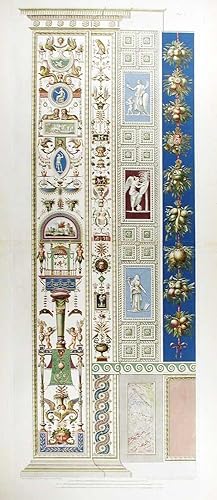

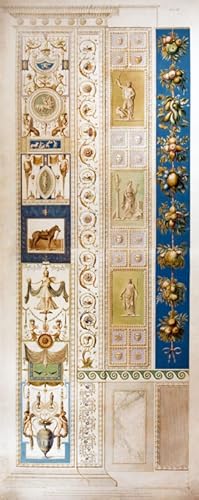
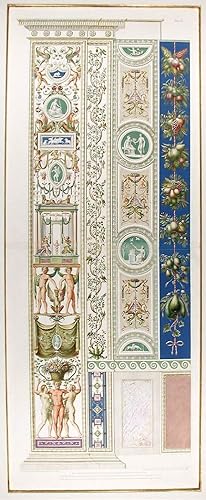
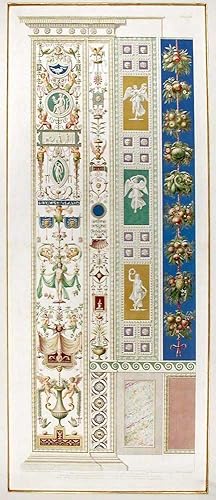
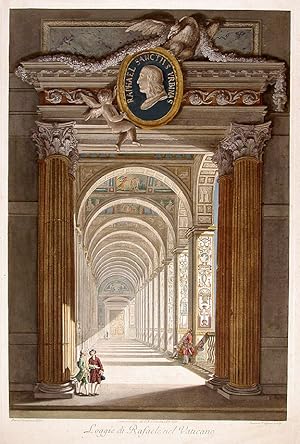
![Image du vendeur pour [Psyches et Amoris nuptiae fabula a Raphaele Sanctio Urbinate Romae in Farnesianis hortis Transtyberim ad veterum aemulationem ac laudem colorum luminibus expressa a. Dorigny. delineata et incisa, et a Ioanne Petro Belloriio notis illustrata] mis en vente par Donald A. Heald Rare Books (ABAA)](https://pictures.abebooks.com/inventory/md/md1186158343.jpg)
